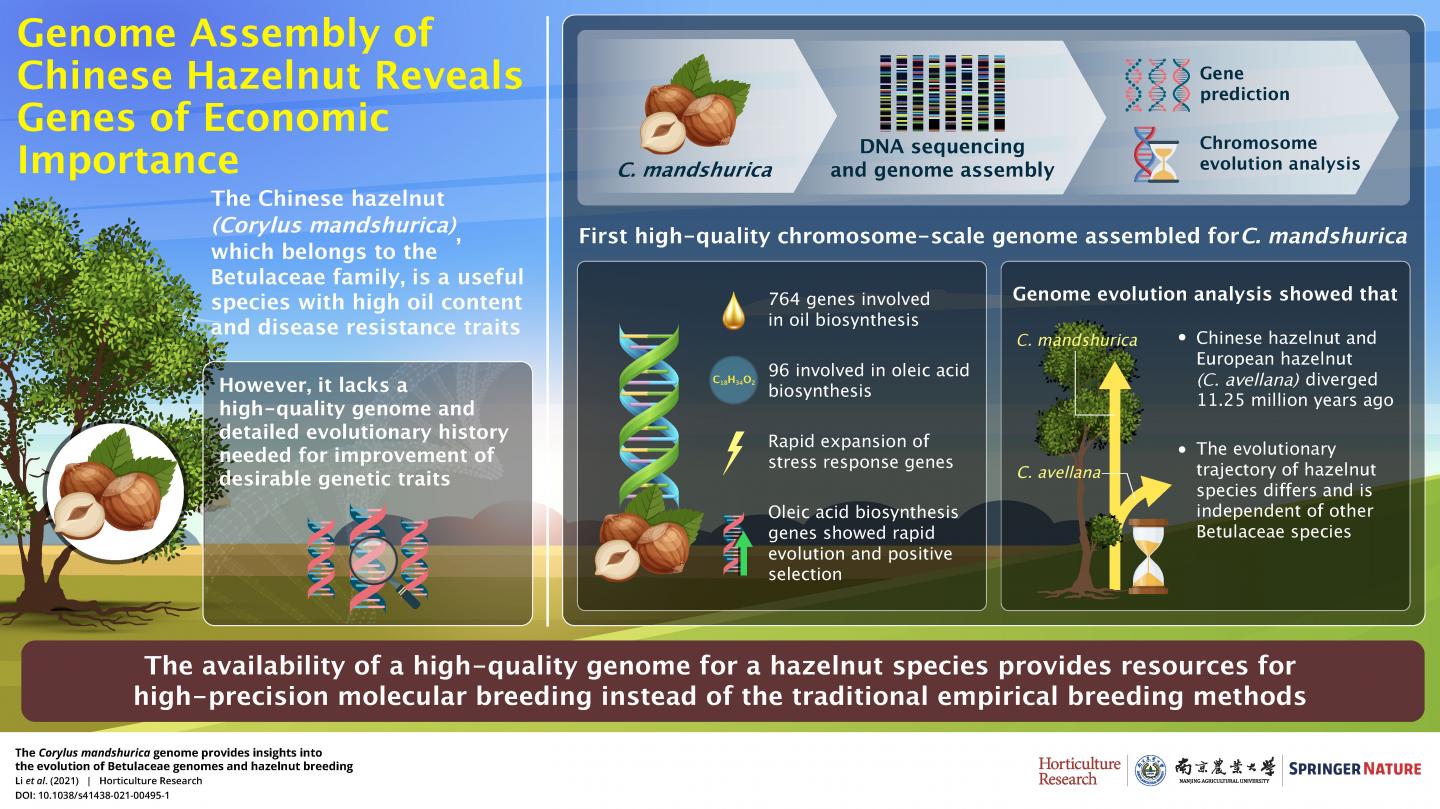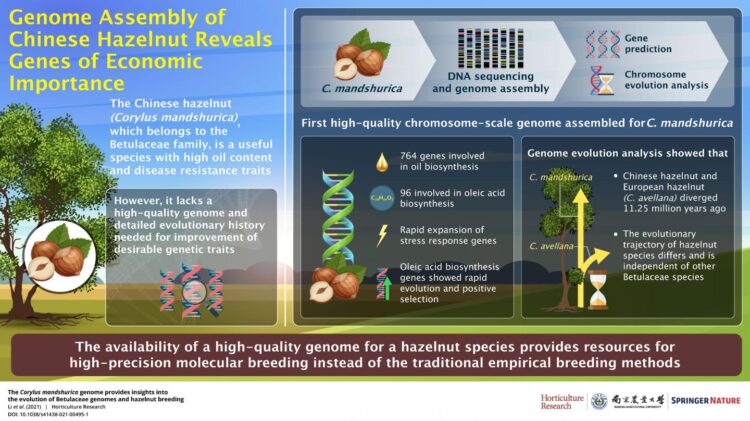Scientists from China assembled a high-quality genome of Chinese hazelnut and were able to identify several genes of economic importance

Credit: Hoticulture Research
Humans have been breeding plants for their economic value for thousands of years. Traditionally, plant breeding techniques included cumbersome and time-consuming techniques like grafting and hybridization to enhance traits of economic value like disease resistance and high nutrition content. Now, with the ability to edit plant DNA using revolutionary gene-editing tools, particularly the CRISPR-Cas9 system, it is possible to enhance traits of economic value in plants easily and more efficiently than by using traditional techniques. But for that, it is necessary to sequence whole genomes of economically important crops and identify all the genes controlling these desirable traits.
Hazelnut is an important commercial crop, being the fourth largest grown nut in the world. It is widely used for its oil content and pleasant flavor for the large-scale preparation of chocolates and biscuits. Hazelnut oil has an important healthy fatty acid called oleic acid, which reduces the risk of cardiovascular diseases. Chinese hazelnut (Corylus mandshurica) has proven to be a useful species because of its high oil content and disease resistance traits. However, it lacks a high-quality genome and information about genes involved in traits like oil synthesis and stress resistance.
A study published in Horticulture Research by a team of scientists from China led by Dr. Ying Li and Dr. Yong-Zhi Yang detailed a comprehensive and enhanced genome of the Chinese hazelnut. As Dr. Li explains, “If the genome of each species is a jigsaw puzzle, our study completed the puzzle of a hazelnut species with high quality and found several key pieces related to the quality of the hazelnut fruit”. They identified 764 genes involved in oil biosynthesis, of which 96 are directly involved in oleic acid biosynthesis.
The ability to grow in stressful conditions is another important trait that plant breeders try to enhance in their crops. Apart from several genes that they found for oil biosynthesis, Dr. Li’s team also found many genes involved in stress resistance. Of them, ten genes related to oil biosynthesis and 38 genes related to stress response undergoing positive nature selection or rapid evolution in the Chinese hazelnut. Since this is the first high-quality genome for this species, researchers also tried to understand how chromosomes have changed between the ancestral Betulaceae karyotype and five Betulaceae species, including Chinese hazelnut. They found that the evolutionary trajectory of hazelnut species is different from and independent of other Betulaceae species.
The low quality of the genetic resources available for hazelnut has long prevented its widespread use in plant breeding. “The new high-quality reference genome presented here constitutes a valuable resource for molecular breeding and genetic improvement of the important agronomic properties of hazelnuts”, Dr. Yang concludes.
Without a doubt, this new genetic resource would guide future breeding efforts and improvements for hazelnut crops worldwide!
###
Reference
Authors
Ying Li, Pengchuan Sun, Zhiqiang Lu, Jinyuan Chen, Zhenyue Wang, Xin Du, Zeyu Zheng, Ying Wu, Hongyin Hu, Jiao Yang, Jianxiang Ma, Jianquan Liu, and Yongzhi Yan
Title of original paper
The Corylus mandshurica genome provides insights into the evolution of Betulaceae genomes and hazelnut breeding
Journal
Horticulture Research
DOI
https:/
Affiliations
1. State Key Laboratory of Grassland Agro-Ecosystem, Institute of Innovation Ecology & School of Life Sciences, Lanzhou University, Lanzhou, China
2. Key Laboratory of Bio-Resource and Eco-Environment of Ministry of Education & State Key Laboratory of Hydraulics & Mountain River Engineering, College of Life Sciences, Sichuan University, Chengdu, China
About Dr. Yong-Zhi Yang
Dr. Yong-Zhi Yang is a Young Researcher at the Institute of Innovation Ecology, Lanzhou University, China. He graduated and completed his PhD from Lanzhuo University in 2018. His main area of interest is molecular ecology and endangered plant protection genomics. He has several publications and co-author publications to his credit.
Media Contact
Xiao Ju
[email protected]
Original Source
https:/
Related Journal Article
http://dx.





